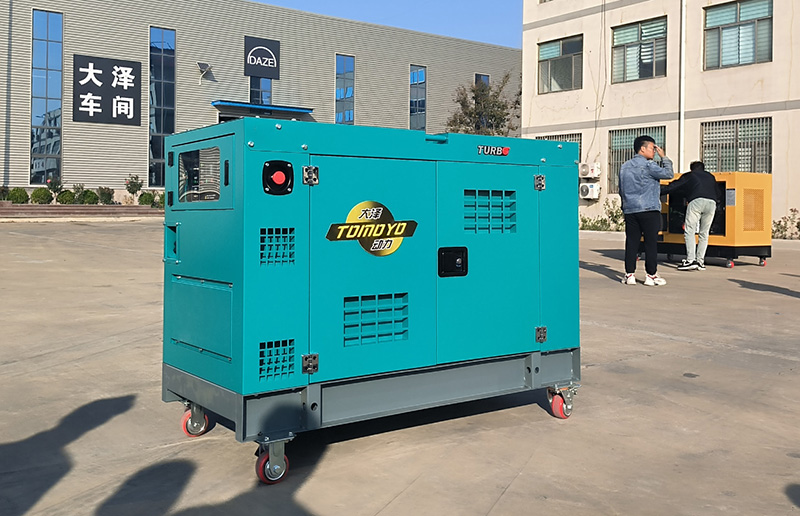Three Phase and Single Phase Generator Sets Application Scenarios and How to Choose Correctly
Release time:2025-09-12 Click:25
As global energy demands rise and reliability becomes critical, generator sets have evolved into indispensable assets across industries. From construction sites to hospitals, choosing between a three-phase and a single-phase generator set can determine operational efficiency and cost savings. For many international buyers working with Chinese manufacturers, understanding these differences is key to making an informed investment.
In this article, we explain the application scenarios of both types of generator sets, discuss their advantages and limitations, and provide practical selection tips to help businesses make the right choice.
Three-Phase Generator Sets Explained
A three-phase generator produces power across three alternating currents that are 120 degrees apart. This design provides smoother, more efficient power delivery for high-demand applications.
Typical applications include: Large construction sites operating multiple heavy-duty tools; industrial facilities running motors, compressors, or pumps; data centers requiring stable, balanced power supply; shipyards, airports, and mining operations.
Advantages: Higher power capacity than single-phase units; more efficient power distribution over long distances; better for running large motors and equipment with high starting loads.
Limitations: Usually larger and more expensive than single-phase generators; overkill for small residential or light commercial loads.
Single-Phase Generator Sets Explained
Single-phase generators deliver power through a single alternating current. They’re simpler and lighter, making them ideal for low to medium power needs.
Typical applications include: Residential backup power for homes and small offices; retail shops, small restaurants, and mobile businesses; rural clinics or schools with limited electrical loads; emergency or temporary power during events.
Advantages: Compact, portable, and easier to install; lower initial investment and maintenance costs; compatible with standard household and small commercial appliances.
Limitations: Limited power output compared to three-phase models; less efficient for long-distance power transmission or heavy loads.
Key Factors in Selecting the Right Generator Set
Choosing between three-phase and single-phase generators involves more than just load size. Consider power requirements, voltage and frequency standards, portability versus stationary use, future expansion, and fuel type.

Frequently Asked Questions
Q1: Can a three-phase generator power single-phase equipment? Yes, with proper wiring or a transformer, a three-phase generator can supply single-phase loads, but efficiency may decrease if loads aren’t balanced.
Q2: Is it possible to convert a single-phase generator to three-phase? Generally no. Single-phase generators are designed for their specific output. Converting to three-phase would require replacing core components.
Q3: What size generator do I need for my business? Start by listing all equipment, their wattage, and starting surges. Add a 20% buffer for safety. Consult a qualified supplier to match your needs with the right unit.
Q4: How does a Chinese manufacturer ensure quality for export markets? Reputable Chinese suppliers comply with international standards such as ISO, CE, or EPA. They offer pre-shipment inspections, technical support, and spare parts to ensure reliability.
Q5: Which fuel option is better for remote locations? Diesel three-phase generators are typically more fuel-efficient for remote or continuous-duty applications. For smaller loads, gasoline or dual-fuel single-phase models may be more practical.
Maintenance Tips and Future Trends
No matter which type of generator you choose, regular maintenance extends lifespan and ensures reliability. Conduct routine inspections of fuel, oil, and coolant levels; run the generator under load at least once a month; replace filters and worn parts on schedule; store the unit in a clean, dry environment.
As renewable energy and smart technology advance, future generator sets will integrate with solar panels, battery storage, and IoT monitoring. Chinese manufacturers are already developing hybrid three-phase systems that automatically balance loads and reduce emissions.
Conclusion
Whether you’re powering a remote clinic, a large-scale construction site, or a backup system for your business, understanding the differences between three-phase and single-phase generator sets is essential. By evaluating your power requirements, future growth, and operational environment, you can select a generator that offers reliability, efficiency, and long-term value. As a Chinese manufacturer exporting generator sets worldwide, we are committed to providing tailored solutions that meet international standards and exceed customer expectations.
Hot products
+86 15244567972
Contacts:Jack
